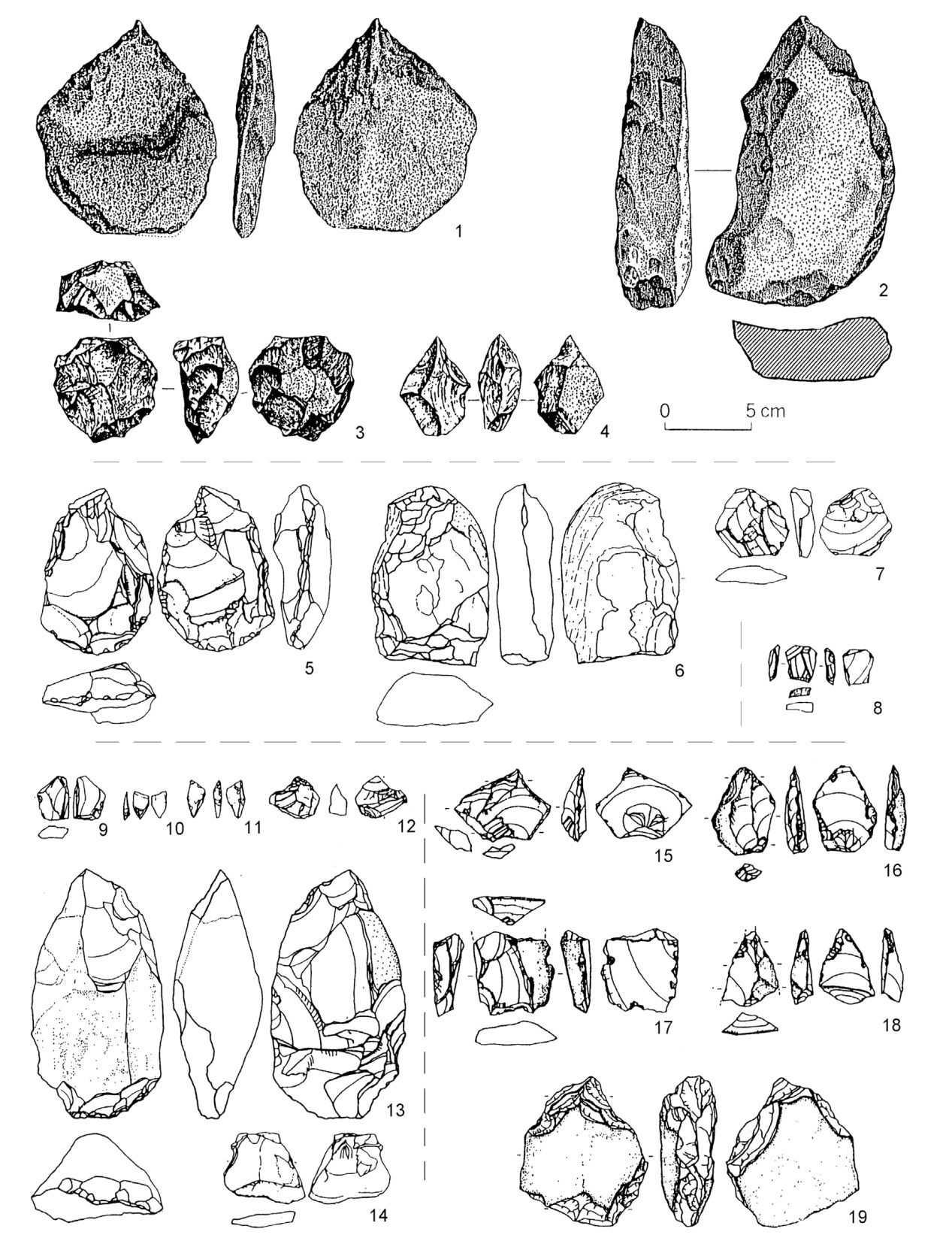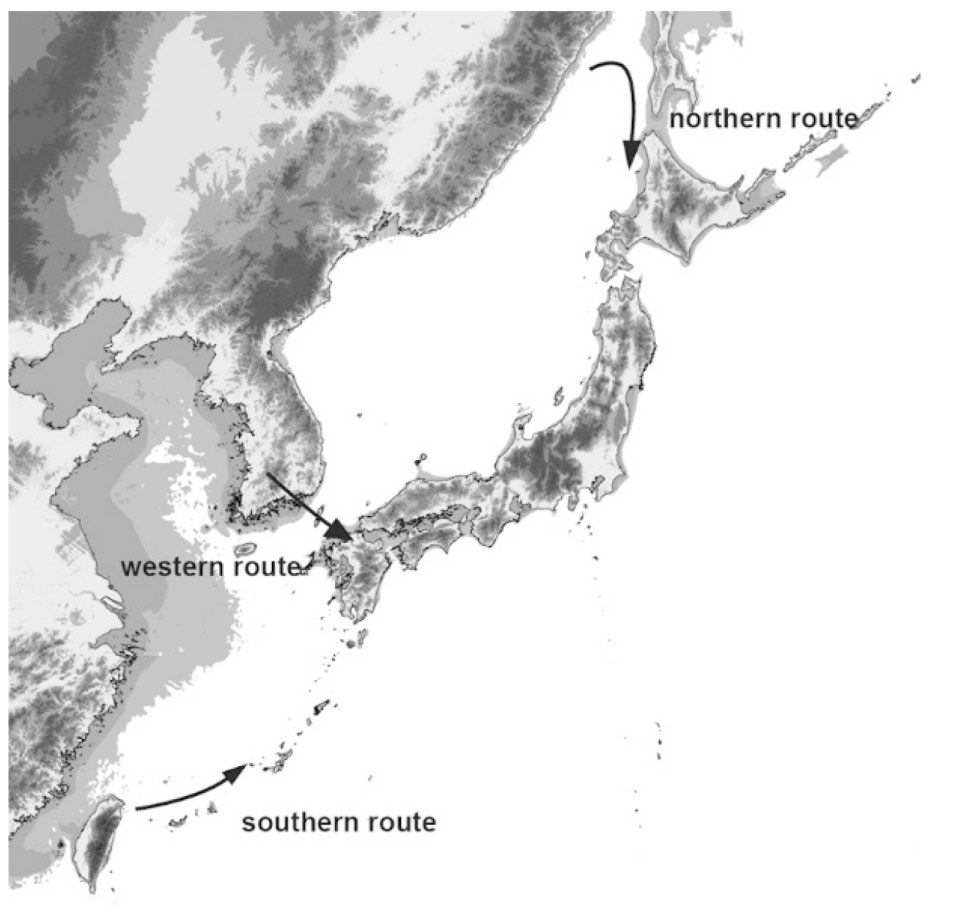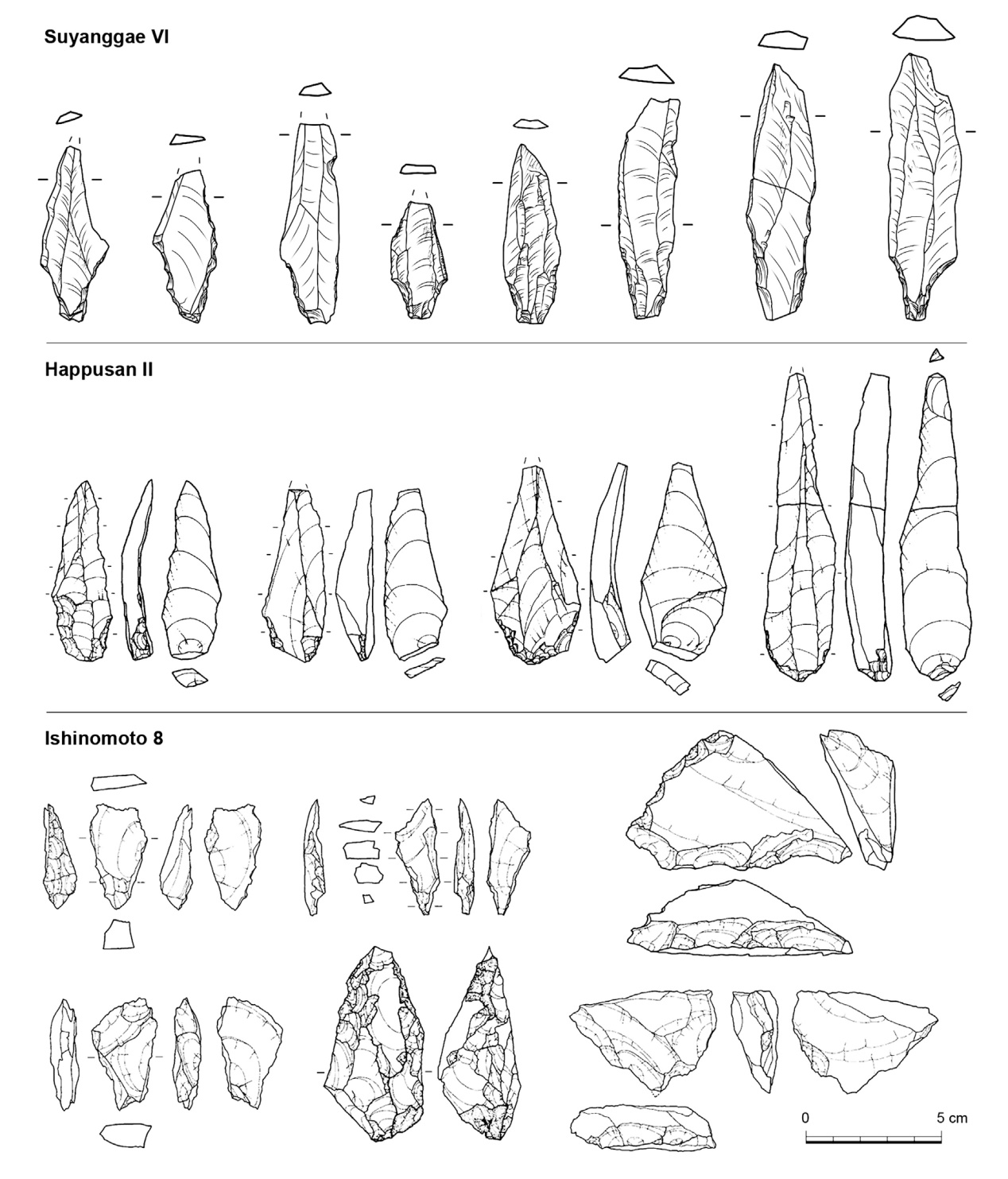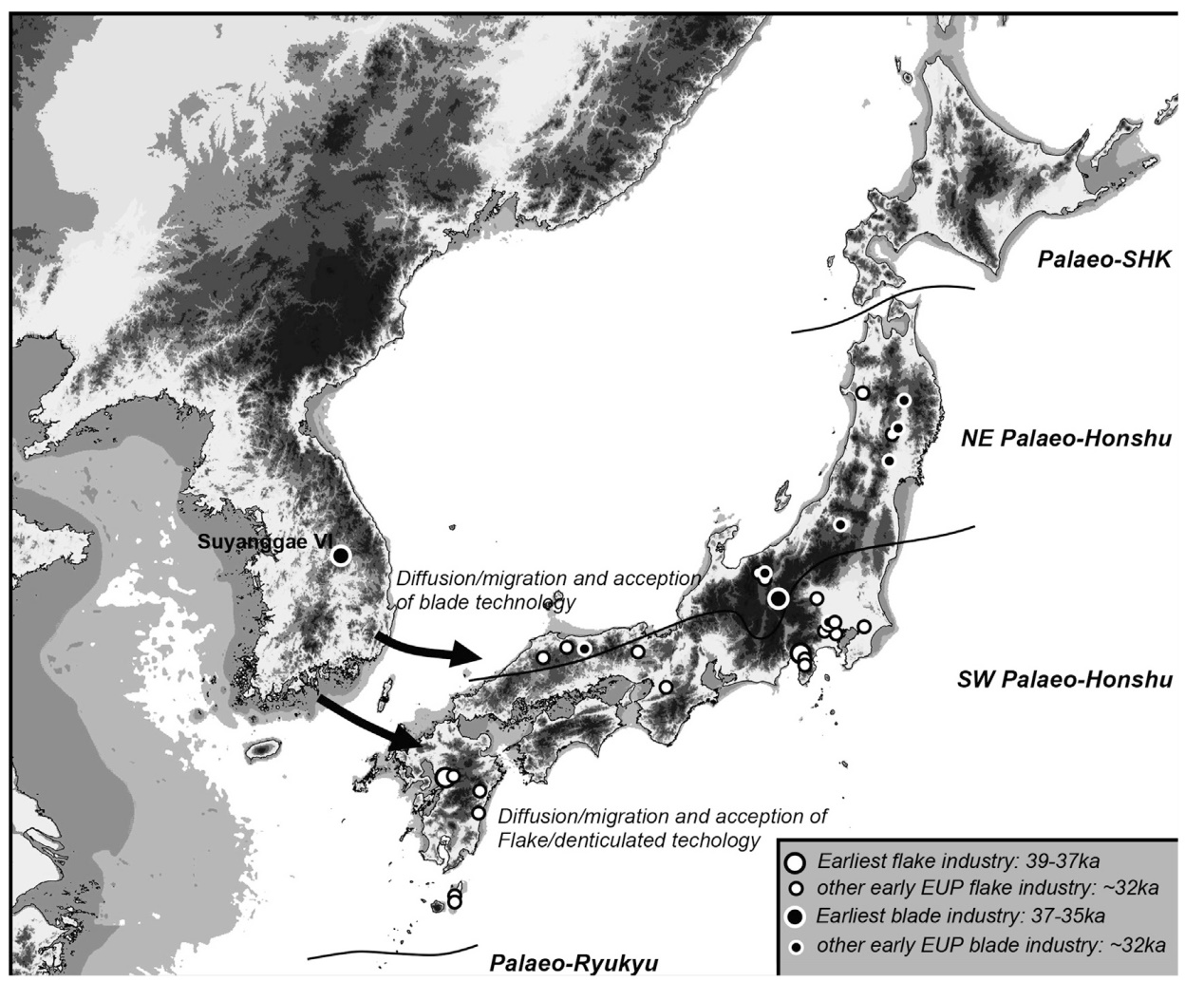| [1] |
Li F, Vanwezer N, Boivin N, Gao X, et al. Heading north: Late Pleistocene environments and human dispersals in central and eastern Asia. PLoS ONE, 2019, 14(5): e0216433
|
| [2] |
Kaifu Y, Izuho M, Goebel T. Modern human dispersal and behavior in Paleolithic Asia:summary and discussion. In: Kaifu Y, Izuho M, Goebel T, Sato H (Eds.). Emergence and Diversity of Modern Human Behavior in Palaeolithic Asia. Texas: Texas A&M University Press, 2015: 535-566
|
| [3] |
Zwyns N, Paine CH, Tsedendorj B, et al. The Northern Route for Human dispersal in Central and Northeast Asia: New evidence from the site of Tolbor-16, Mongolia. Scienctific Reports, 2019, 9(1): 11759
|
| [4] |
Izuho M, Kaifu Y. The appearance and characteristics of the early Upper Palaeolithic in the Japanese Archipelago. In: Kaifu Y, Izuho M, Goebel T, Sato H (Eds.). Emergence and Diversity of Modern Human Behavior in Palaeolithic Asia. Texas: Texas A&M University Press, 2015: 289-313
|
| [5] |
Sato H. Recent advances of the Initial Upper Palaeolithic study in Asia: Estimating the lithic assemblages of third and fourth cultural layers in the Locality 6 of the Suyanggae Site. Journal of the Korean Palaeolithic Society, 2017, 35: 5-20 (in Japanese with English abstract)
|
| [6] |
Sato H. Formation process of territoriality and prehistoric societies in Upper Palaeolithic Kyushu and Hokkaido. In: Yoshidome Hidetoshi shi Tsuito Ronshu Kankokai (Ed.). Isekigaku no Chihei [Perspectives on Archaeological Site Research]. Fukuoka: Yoshidome Hidetoshi shi Tsuito Ronshu Kankokai, 2020: 1-8 (in Japanese)
|
| [7] |
Morisaki K, Sano K, Izuho M. Early Upper Paleolithic blade technology in the Japanese Archipelago. Archaeological Research in Asia, 2019, 17: 79-97
doi: 10.1016/j.ara.2018.03.001
|
| [8] |
Anzai M, Sato H. Transition from Middle to Upper Palaeolithic in Japan. In:Proceedings of the International Symposium ‘Chronostratigraphy of Paleolithic of North, Central, East Asia and America (Paleoecological Aspect). Novosibirsk: Soviet Scientific Academy Siberian Branch, 1990: 97-105
|
| [9] |
Matsufuji K. Study of the Origin of the Upper Palaeolithic Culture in the Japanese Archipelago. Osaka: Kyowa Press Inc, 2004: 1-143 (in Japanese with English abstract)
|
| [10] |
Tamura T. Neighbors, not auslanders: some thoughts on the appearance of laminar technologies in the Japanese Archipelago. Quarterly of Archaeological Studies, 2015, 61(4): 24-44 (in Japanese with English abstract)
|
| [11] |
Kunitake S, Sutou T, Tsutsumi T. The assemblage and the origin of the oldest blade industryin the Japanese Archipelago. Kyusekki Kenkyu [Palaeolithic Research], 2021, 17: 125-146 (in Japanese with English abstract)
|
| [12] |
Morisaki K, Kunikita D, Ikeda T, et al. Ishinomoto revisited: A chronological study on the beginning of the Upper Palaeolithic Period in the Japanese Archipelago. Kyusekki Kenkyu [Palaeolithic Research], 2020, 16: 43-58 (in Japanese with English abstract)
|
| [13] |
Kudo Y. Environment and culture history of the Upper Palaeolithic and the Jomon Period: high-precision radiocarbon dating and archaeology. Tokyo: Shinsensha, 2012, 1-373 (in Japanese)
|
| [14] |
Takahara H, Hayashi R. Paleovegetation during Marine Isotope Stage 3 in East Asia. In: Kaifu Y, Izuho M, Goebel T, Sato H (Eds.). Emergence and Diversity of Modern Human Behavior in Palaeolithic Asia. Texas: Texas A&M University Press, 2015, 314-324
|
| [15] |
Lambeck K, Roubya H, Anthony P, et al. Sea level and global ice volumes from the Last Glacial Maximum to the Holocene. PNAS, 2014, 111-43: 15296-15303
|
| [16] |
Sato H. Chinese, Korean, and Japanese Palaeolithic.In: Executive Committee of Iwajuku Forum (Ed.). Proceedings of the 7th Iwajuku Forum. Gunma: Kasakake-cho Board of Education, 1999: 37-43 (in Japanese)
|
| [17] |
Matsui H, Tada R, Oba T. Low-salinity isolation event in the Japan Sea in response to eustatic sea-level drop during LGM: reconstruction based on salinity-balance model. Daiyonki Kenkyu [The Quaternary Research], 1998, 37: 221-233 (in Japanese with English abstract)
|
| [18] |
Yoo DG, Lee GS, Kim GY, et al. Seismic stratigraphy and depositional history of late Quaternary deposits in a tide-dominated setting: An example from the eastern Yellow Sea. Marine and Petroleum Geology, 2016, 73: 212-227
|
| [19] |
Sato H. A perspective on the Middle Paleolithic study of the East Asia. In: Derevianko AP, Shunkov MV (Eds.). Proceedings of the International Symposium “Early Human Habitation of Central, North and East Asia: Archaeological and Paleoecological Aspects”. Novosibirsk: Institute of Archaeology and Ethnography Press, 2005: 161-171
|
| [20] |
Iwase A, Hashizume J, Izuho M, et al. The timing of megafaunal extinction in the late Late Pleistocene on the Japanese Archipelago. Quaternary International, 2012, 255: 114-124
|
| [21] |
Sato H, Yamada S, Izuho M. Terrestrial resources and hunting activity in Upper Palaeolithic in Japanese Islands. In: Sato H, Iinuma K (Eds.). No to Hara no Kankyoshi [Environmental History of Grassland in the Japanese Archipelago]. Tokyo: Bun-ichi Sogo Shuppan, 2011: 51-72 (in Japanese)
|
| [22] |
Morisaki K, Izuho M, Terry K, et al. Lithics and climate: technological responses to landscape change in Upper Palaeolithic northern Japan. Antiquity, 2015, 89(345): 554-572
|
| [23] |
Takahashi K, Izuho M. Formative history of terrestrial fauna of the Japanese Islands during the Plio-Pleistocene. In: Ono A, Izuho M (Eds.). Environmental Changes and Human Occupation in East Asia during OIS3 and OIS2 (BAR International Series 2352). Oxford: British Archaeological Reports Ltd, 2012: 73-86
|
| [24] |
Sato H. Trap-pit hunting in Late Pleistocene Japan. In: Kaifu Y, Izuho M, Goebel T, Sato H (Eds.). Emergence and Diversity of Modern Human Behavior in Palaeolithic Asia. Texas: Texas A&M University Press, 2015: 389-405
|
| [25] |
Yamazaki S. Palaeolithic humans and coastal subsistence: a view from the margin. Palaeolithic Kyushu, 2020, 24: 223-246 (in Japanese with English abstract)
|
| [26] |
Sato H. The framework of the Upper Palaeolithic cultures in the Japanese Archipelago, and Hokkaido and Kyushu Island. Kyushu Kyusekki [Palaeolithic Kyushu], 2000, 4: 71-82 (in Japanese)
|
| [27] |
Sato H. Early Upper Paleolithic Industries in Hokkaido, Japan. In: Деревянко АП (Ed.). Проблемы Археологии и Палеоэкологии Северной и Центральной Азии. Novosibirsk: Institute of Archaeology and Ethnography Press, 2003: 243-246
|
| [28] |
Kaifu Y, Fujita M, Yoneda M, et al. Pleistocene seafaring and colonization on the Ryukyu Islands, Southwestern Japan. In: Kaifu Y, Izuho M, Goebel T, Sato H (Eds.). Emergence and Diversity of Modern Human Behavior in Palaeolithic Asia. Texas: Texas A&M University Press, 2015: 345-361
|
| [29] |
Fujita M, Yamasaki S, Sawaura R. The migration, culture and lifestyle of the Paleolithic Ryukyu Islanders. In: Ono R, Pawlik A, (Eds.). Pleistocene Archaeology- Migration, Technology, and Adaptation. London: IntechOpen (open access eBook), 2020: 1-15
|
| [30] |
Sato H. Recent research on the Early and Middle Palaeolithic in Japan: an overview. Bulletin of the Society for East Asian Archaeology, 2016, 3: 29-35
|
| [31] |
Yoshikawa S, Kawamura Y, Taruno H. Land bridge formation and proboscidean immigration into the Japanese Islands during the Quaternary. Journal of Geosciences, Osaka City University, 2007, 50(1): 1-6
|
| [32] |
Sato H. Human behavior responses to environmental and resource fluctuation in the Pleistocene Japanese Archipelago. In: Tanaka Yoshiyuki Sensei Tsuito Ronshu Kankokai (Ed.). Archaeology: Is it Science? Fukuoka: Chugoku-Shoten, 2016: 199-214 (in Japanese)
|
| [33] |
Komura H. Aichi ken kaseizawa kyûsekki jidai iseki [The Kaseizawa Palaeolithic Site]. Tokyo: Genbunsha, 1968, 1-61 (in Japanese)
|
| [34] |
Sato H. Emergence of east Asian Upper Palaeolithic. Ibou, 2008, 26: 2-15 (in Japanese)
|
| [35] |
Sato H. Re-examination of Middle/Upper Palaeolithic transition in the Japanese Archipelago. Al-RĀFIDĀN, 2017, 38: 55-60 (in Japanese)
|
| [36] |
Kikuchi K (Ed.). Kanedori iseki [Kanedori Site]. Iwate: Miyamori Village Board of Education, 1986: 1-61 (in Japanese)
|
| [37] |
Kuroda A (Ed.). Kanedori iseki: dai 2·3 ji hakkutsu chôsa hôkokusho [The 2nd and 3rd Excavation Report of Kanedori Site]. Iwate: Miyamori Village Board of Education, 2005: 1-132 (in Japanese)
|
| [38] |
Kikuchi K (Ed.). Kashiyamatate ato hakkutsu chôsa hôkokusho [Excavation Report of Kashiyamatate site]. Iwate: Iwate Prefectural Archaeology Center, 1996: 1-295 (in Japanese)
|
| [39] |
Japanese Palaeolithic Research Association. Paleolithic Sites in the Japanese Islands: A Database. Tokyo: Japanese Palaeolithic Research Association, 2010: 1-377 (in Japanese)
|
| [40] |
Nakazawa Y. On the Pleistocene population history in the Japanese Archipelago. Current Anthropology, 2017, 58: S539-S552
|
| [41] |
Sato H. Kyusekki Jidai: Nihon Bunka no Hajimari [Palaeolithic Period: Emergence of Japanese Culture]. Tokyo: Keibun-Sha, 2019: 1-127 (in Japanese)
|
| [42] |
Naoe Y, Nagasaki J. Lithic raw material consumption strategy of the Early Upper Paleolithic in Hokkaido. Hokkaido Kyusekki Bunka Kenkyu [Paleolithic Culture Research in Hokkaido] 2005, 10: 45-58 (in Japanese)
|
| [43] |
Izuho M, Akai F. Geochronology of Palaeolithic sites in Hokkaido, Japan. Kyusekki Kenkyu [Palaeolithic Research] 2005, 1: 39-55 (in Japanese with English abstract)
|
| [44] |
Terasaki Y. The Chronology of Paleolithic in Hokkaido. In: Anzai M, Sato H (Eds.). Kyusekki Jidai no Chiiki Hennenteki Kenkyu [Regional Chronological Studies of the Paleolithic Period in the Japanese Archipelago]. Tokyo: Doseisha, 2006: 275-314 (in Japanese)
|
| [45] |
Izuho M, Kunikita D, Nakazawa Y, et al. New AMS dates from the Shukubai-Kaso site (Loc. Sankakuyama), Hokkaido (Japan): Refining the chronology of small flake-based assemblages during the Early Upper Palaeolithic in the Palaeo-Sakhalin-Hokkaido-Kurile Peninsula. PaleoAmerica, 2018, 4(2): 134-150
|
| [46] |
Izuho M, Morisaki K, Oda N, et al. Surface collections from Akita 10 site. In: Sato H (Ed.). Research on the Relationships between Human and Environmental Fluctuation in the Northern Circum Japan Sea Area (NCJSA) in Late Pleistocene. Hokkaido: University of Tokyo, 2011, 98-121 (in Japanese)
|
| [47] |
Oda N, Morisaki K. Recent problems surrounding the Early Upper Palaeolithic site of Akita 10, Hokkaido, Japan. Kyusekki Kenkyu [Paleolithic Research], 2016, 12: 217-225 (in Japanese with English abstract)
|
| [48] |
Nakazawa Y, Izuho M, Takakura J, et al. Toward an Understanding of Technological Variability in Microblade Assemblages in Hokkaido, Japan. Asian Perspectives, 2005, 44: 276-292
|
| [49] |
Sato H, Tsutsumi T. The Japanese microblade industries:technology, raw material procurement and adaptation. In: Kuzmin Y, Keats S, Shen C (Eds.). Origin and Spread of Microblade Technology in Northern Asia and North America. Burnaby, BC: SFU Archaeology Press, 2007: 53-78
|
| [50] |
Kudo Y, Kumon F. Palaeolithic cultures of MIS3 to MIS1 in Relation to Climate Changes in the Central Japanese Islands. Quaternary International, 2012, 248: 22-31
|
| [51] |
Ikeda T (Ed.). Isinomoto isekigun II [Ishinomoto Sites II]. Kumamoto: Kumamoto Prefecture Board of Education, 1999: 1-226 (in Japanese)
|
| [52] |
Harada Y (Ed.). Idemaruyama iseki hakkutsu chosa hokokusho [Excavation Report of Idemaruyama Site]. Shizuoka: Numazu City Board of Education, 2011: 1-120 (in Japanese)
|
| [53] |
Machida H, Arai F. Atlas of Tephra in and around Japan (Revised Edition). Tokyo: The University of Tokyo Press, 2003: 1-360 (in Japanese)
|
| [54] |
Oda S, Keally CT. Japanese Paleolithic Cultural Chronology; Occasional Papers 2. Tokyo: Archaeological Research Center, International Christian University, 1975
|
| [55] |
Shibutani A. Starch residues on stone tools from the Tachikiri, Kakuriyama, Soujiyama and Okunonita Sites: Material. Kodai Bunka [Cultura Antiqua], 2008, 60(1): 130-140 (in Japanese)
|
| [56] |
Sato H. Three Paleolithic cultures in the Japanese Archipelago. In: Saidin M, Lee YJ, Woo JY (Eds.). Proceedings of the 23rd Suyanggae International Symposium in Malaysia “Suyanggae and Lenggong: Prehistory Adaptation” Penang: Organization Committee, 2018. 23-33
|
| [57] |
Nakaza H (Ed.). Report on Survey Excavation of the Shiraho-Saonetabaru Cave Site. Okinawa: Okinawa Prefectural Archaeology Center, 2017: 1-201 (in Japanese with English abstract)
|
| [58] |
Sato H. Pleistocene burials and cemetery:new discovery at the Shiraho-saonetabaru Cave Site, Ishigaki Island in the southernmost Japan. In: Nakamura S, Adachi T, Abe M (Eds.). Decades in Deserts: Essays on Near Western Archaeology in Honor of Sumio Fujii. Tokyo: Rokuichi-Shobo, 2019: 357-362
|
| [59] |
Sato T, Nakagome S, Watanabe C, et al. Genome-wide SNP analysis reveals population structure and demographic history of the Ryukyu islanders in the southern part of the Japanese archipelago. Molecular Biology and Evolution, 2014, 31: 2929-2940
doi: 10.1093/molbev/msu230
pmid: 25086001
|
| [60] |
Ikeya N. Maritime transport of obsidian in Japan during the Upper Paleolithic. In: Kaifu Y, Izuho M, Goebel T, Ono A (Eds.). Emergence and Diversity of ModernHuman Behavior in Paleolithic Asia. Texas A & M University Press, College Station, 2015: 362-375
|
| [61] |
Sato H. Chronological significance and human behavior of the third cultural layer in the Ushiromuta Site. In Tachibana M, Sato H, Yamada S (Eds.). Research Report of the Ushiromuta Site. Miyazaki: Kawaminami-cho Board of Education, 2002: 382-395 (in Japanese)
|
| [62] |
Kato S. The Paleolithic of China: Its industries and chronology. Kyusekki Kenkyu [Palaeolithic Research], 2019, 15: 91-105 (in Japanese with English abstract)
|
| [63] |
Li F, Kuhn SL, Bar-Yosef O, et al. History, Chronology and Techno-Typology of the Upper Paleolithic Sequence in the Shuidonggou Area, Northern China. Journal of World Prehistory, 2019, 32: 111-141
|
| [64] |
Nagai K. Lithic industries during the past 50,000 years in Korean Peninsula: Evaluating the radiocarbon chronology of the middle to upper Paleolithic Transition. Kyusekki Kenkyu [Palaeolithic Research], 2016, 12: 185-206 (in Japanese with English abstract)
|
| [65] |
Sudo T (Ed.). Happusan iseki gun [Happusan Sites]. Nagano: Saku City Board of Education, 1999, 1-619 (in Japanese)
|
| [66] |
Zwyns N, Gladyshev S, Tabarev A, et al. Mongolia:Paleolithic. In: Smith C (Ed.). Encyclopedia of Global Archeology Vol.8. New York: Springer-Verlag, 2014, 5025-5032
|
| [67] |
Zwyns N, Lbova LV. The Initial Upper Paleolithic of Kamenka site, Zabaikal region (Siberia): A closer look at the blade technology. Archaeological Research in Asia, 2019, 17: 24-49
doi: 10.1016/j.ara.2018.02.004
|
| [68] |
Lee HJ, Lee SS. Chronology and characteristics of the Upper Palaeolithic blade tool industry in Korea. Acta Anthropologica Sinica, 2019, 38(3): 373-388
|
| [69] |
Lee GK. The characteristics of Upper Paleolithic industries in Korea. In: Kaifu Y, Izuho M, Goebel T, Sato H (Eds.). Emergence and Diversity of Modern Human Behavior in Palaeolithic Asia. Texas: Texas A&M University Press, 2015: 270-286
|
| [70] |
Han CG. The Yongho-dong site and Palaeolithic culture. Daejeon Munhwa, 2002, 11: 91-105 (in Korean)
|
| [71] |
Seong C. Evaluating radiocarbon dates and Late Palaeolithic chronology in Korea. Arctic Anthropology, 2011, 48(1): 93-112
|
| [72] |
Choi BK, Ryu HJ. Pocheon Hwadaeri Shimteo Guseokki Yujeok [The Hwadaeri Shimteo Paleolithic Site. Pocheon City, Korea]. Chuncheon: Doseochulpan Sanchaek, 2005 (in Korean)
|
| [73] |
Lee YJ, Woo JY. Suyanggae:why so important? In: Derevianko AP, Drozdov NI (Eds.). Topocal issues of the Asian Paleolithic. Novosibirsk: Institute of Archaeology and Ethnography Press, 2014: 129-135
|
| [74] |
Lee YJ, Woo JY, Lee SW, et al. Report on the Excavation of Suyanggae Site (Loc.I and VI), Danyang. Cheougju: Institute of Korean Prehistory, 2018: 1-821 (in Korean with English and Japanese abstract)
|
| [75] |
Morisaki K. Structural Changes and Regional Adaptation of Palaeolithic Society. Tokyo: Rokuichi-Shobo, 2010: 1-262 (in Japanese)
|
| [76] |
Morisaki K. The evolution of lithic technology and human behavior from MIS 3 to MIS 2 in the Japanese Upper Paleolithic. Quaternary International, 2012, 248: 56-69
|







